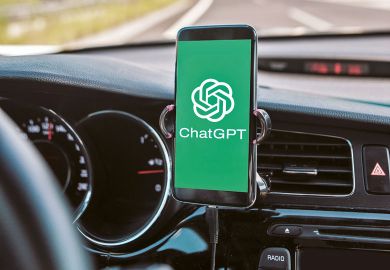Lee Tremblay was concerned when Georgetown University Law Center announced last year that it would be using Otter, an artificial intelligence-powered transcription service, instead of relying on the human note takers Ms Tremblay had used for the previous two years of law school.
“They were really excited, and I was really skeptical,” said Ms Tremblay, former president of the Disability Law Student Association. “I tried it. I hated it. And others came to me saying, ‘This is completely unworkable; you have to do something about this.’”
Ms Tremblay authored an article for the Georgetown Law Technology Review detailing the actions needed to ensure that the new technology met student accommodations requirements and was ultimately able to switch back to receiving notes from a human note taker.
While the tensions over the transcription apps at Georgetown Law were new at the time, discussions about their use are becoming increasingly common. AI recording devices are creeping into the classroom as students become more familiar with – and reliant on – AI in general. With that comes a litany of questions around privacy concerns, consent and the efficacy of taking notes the old-fashioned way versus via robots.
But despite many of those questions remaining unanswered, students are moving full speed ahead with the devices.
“It’s all just now coming to the forefront,” said Marc Watkins, a professor at the University of Mississippi. “The real challenge is faculty don’t know about it, and a lot of the developers are going to social media and selling directly to students, not as a learning aid but as a mechanism to [stop their] listening skills.”
How effective could it be?
But for students such as Ms Tremblay, who requested a human note taker as an accommodation, AI transcription inaccuracies made what should have been a simpler solution much more difficult in the end.
“I think everyone should have access to whatever tool works for them; there are people where Otter worked out great,” said Ms Tremblay, who graduated law school last year and now works at Legal Voice, an Idaho non-profit organisation that advocates for and protects the rights of women and LGBTQ+ people. “Unfortunately for the students who it’s not working for, you shouldn’t have to spend hours correcting a transcript – because then it’s not actually an accommodation.”
Most universities offer note takers to students who request the accommodation. The note takers, who are also students, take notes highlighting important and pertinent information covered in class lectures. The notes are then provided to students who were unable to take their own notes and requested the service. In Ms Tremblay’s case, the note taker saved the notes in Dropbox, not knowing which student would be using them, and Ms Tremblay was able to access them.
Professor Watkins served as a volunteer note taker when he was a student at the University of Central Missouri. He said students using the apps to transcribe notes is one thing, but the apps that create flash cards or practice tests based off transcriptions could prove detrimental to long-term learning.
“If you’re using AI to listen, synthesise and create flash cards, you’re basically just listening for the test and then it’s out of your mind,” he said.
Genevieve Rice, a rising senior at the University of Michigan’s Ann Arbor campus, is a growing rarity among her classmates – she takes her notes by hand rather than using a tablet or a laptop. But despite her old-school leanings, she said if there was an AI tool that was freely available, she would gladly use it.
“I’ve found [writing out my notes] helps things stick in my mind a little bit better, but I spend so much time taking notes that I sometimes can’t really engage with the class as much,” said Ms Rice, an Asian studies major and graphic design minor. “And now if I am engaged in the class, then I can’t take notes.”
Ms Rice said she would use the AI-generated flash cards and practice quizzes in addition to, rather than as a replacement for, her own note-taking.
“I started making flash cards for vocabulary at the start of this semester, was good for about a week, but then putting extra vocab words into flash-card format became too much of a hassle,” she said. “It would’ve been great to have an app for that. It would be an additional learning tool that I would otherwise not have access to because of the workload.”
Daniel Limma, director of Northwestern University’s Law and Technology Initiatives, said that beyond the potential efficiency – or not – of the AI note-taking apps, privacy was a huge concern. There could be data leaks, and the recordings from lecturers, as well as other students’ thoughts during discussion sessions, could be used to train the AI models.
Despite, or perhaps because of, those concerns, he thinks universities should begin working with the AI transcription companies instead of banning them.
“There are absolutely tremendous privacy questions. So sure, it would be better if universities figured out what’s the value [proposition] for students,” he said. “And [they] should think how to integrate the platforms so students use them in a way that’s responsible and compliant with laws that apply.”
What goes into a policy
Many universities have yet to form any policy on AI use in general, let alone a stand-alone policy for using AI recorders in class. Several law professors stated that they believe the legality of recording in a lecture hall is dependent on the state, similar to recording phone calls; some states require single-party consent, where one member of the party knows a recording is occurring, while other states require both parties to agree to the recording.
Fordham University has not set a hard-and-fast policy on recording, but in September, university officials released “etiquette and considerations” guidelines for using AI note takers, which was specifically focused on the recorders that cropped up on the Zoom and Microsoft Teams apps during the Covid-19 pandemic.
“The proliferation of these apps showed up, and it was, ‘Oh, cool, we don’t have to take notes or [meeting] minutes,’” to ‘Oh, that’s a concern,’” said Jason Benedict, chief information security officer at Fordham, who wrote the etiquette and consideration guidelines. “Nothing’s bad, it’s not a showstopper, it’s just things to know.”
Mr Benedict classifies the guidelines as “mostly common sense”: they suggest informing participants, gaining consent and respecting confidentiality. A. T. Still University, a Missouri medical school, issued similar guidelines, urging faculty and students to alert each other when using a note-taking app and to review the notes with the knowledge that there would most likely be some inaccuracies.
Professor Limma noted that Northwestern’s policy banning students from recording in a classroom is posted online, and faculty members are also encouraged to mention it in course syllabuses. The university also records the lecture portion of courses for students who might miss the class.
Professor Limma said he was generally against banning these technologies, given their potential benefits. He added that even if there was a ban on recording devices, students could much more easily utilise them now than in the past.
“I can’t say I’ve noticed people recording. But one of the ethical questions is that it’s easier to record and no one would ever know,” he said. “You have an app on your phone or laptop; it’s not like someone has a large tape recorder on their desk.”
Last month, Professor Watkins wrote a Substack post titled “AI’s Promise to Pay Attention for You”, which detailed the imminent rise of the AI recording apps. He agreed with Professor Limma in opposing a banning on them and said they could provide an opportunity for faculty to reflect on potentially necessary changes in the classroom.
“You can’t ban this, but you do want to talk to students about it and focus on your own teaching and learning,” said Professor Watkins, who is also director of the AI Summer Institute for Teachers of Writing at Ole Miss. “If you’re only doing lectures, it’s probably not the best way to teach anyway. If you break into small groups of discussion, have debates, get them involved in active learning strategy…that will be the best thing possible.”
This is an edited version of a story that first appeared on Inside Higher Ed.
Register to continue
Why register?
- Registration is free and only takes a moment
- Once registered, you can read 3 articles a month
- Sign up for our newsletter
Subscribe
Or subscribe for unlimited access to:
- Unlimited access to news, views, insights & reviews
- Digital editions
- Digital access to THE’s university and college rankings analysis
Already registered or a current subscriber?








